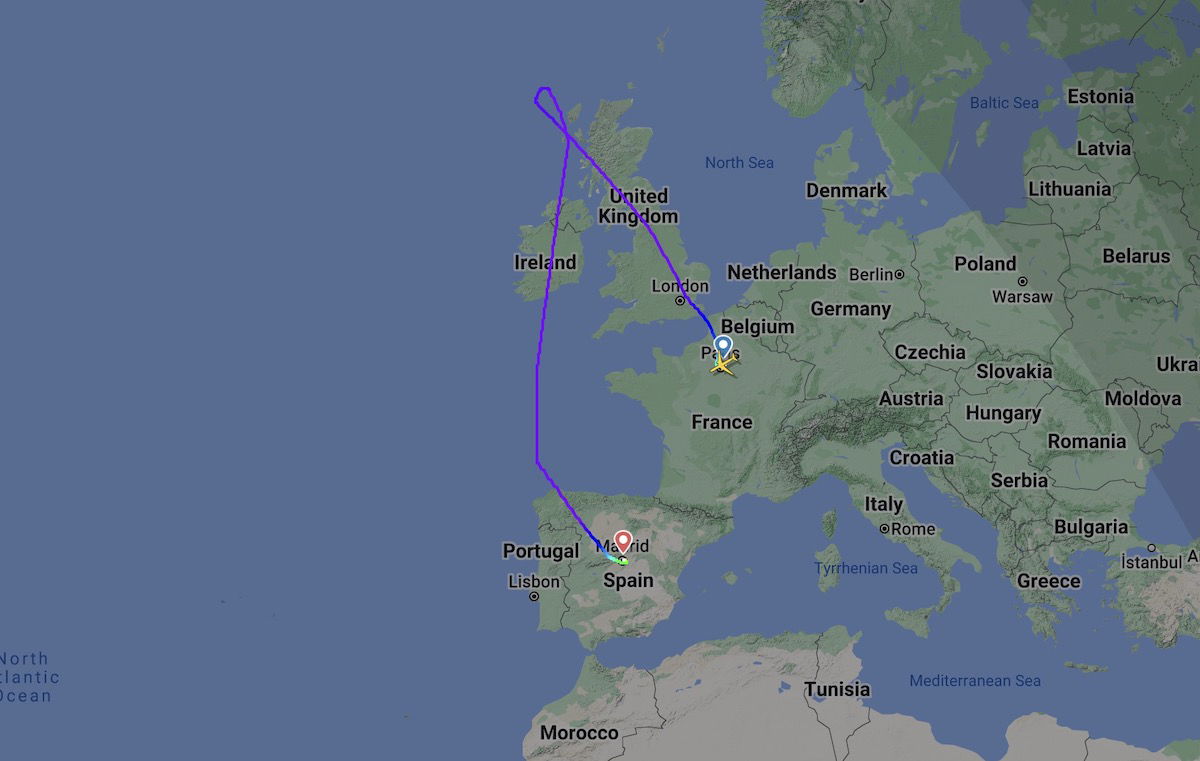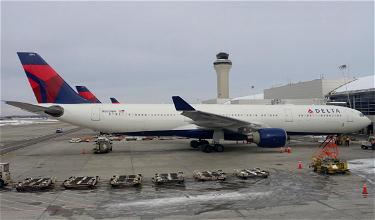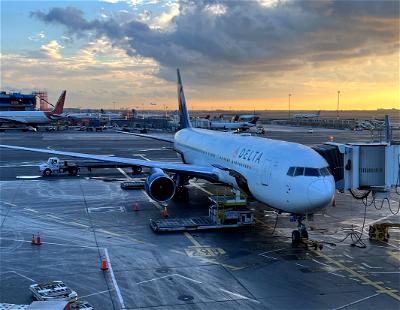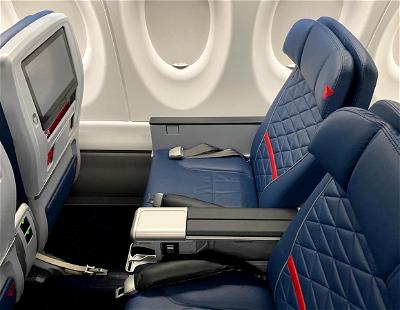Flight diversions happen all the time, and for a variety of reasons. There’s a lot of thought that goes into picking a diversion point. Usually it’s easy to make sense of the logic, though here’s one of the more unusual ones…
In this post:
Paris to Salt Lake City flight diverts to Madrid
Today (Tuesday, January 10, 2023), Delta Air Lines flight DL221 was scheduled to fly from Paris (CDG) to Salt Lake City (SLC). The flight was operated by a roughly 19-year-old Airbus A330-300 with the registration code N805NW.
The flight departed as planned, and for nearly two hours maintained its scheduled route, flying northwest across the United Kingdom. As the flight was about to start its transatlantic crossing, the decision was made to divert due to a technical issue.
At this point you’d think the plane would divert to a nearby airport like Dublin, London, or even Paris. But the plane actually diverted to a farther airport. The plane went from flying northwest to flying south, and flew all the way to Madrid. That diversion took well over three additional hours.

In the end, the flight took over five hours, ending up not all that far from its origin of Paris. As you’d expect, this got a lot of avgeeks on the internet curious, since this is an unconventional diversion. Why would the plane divert to an airport that isn’t even close to where the technical issue started?
Was it because the plane needed to burn off fuel, so Madrid seemed like the right distance? Was it because the decision was made that aircraft maintenance could be performed there? Was it because there was an easy way to accommodate passengers there? Was a spare part that was needed available there? As it turns out, nope, it’s none of those…
Madrid was chosen because of the temperature
As it turns out, the issue with the aircraft involved the anti-ice system. So the plane needed to divert to the closest major airport without cold and icy conditions on the ground, and that turned out to be Madrid.
As noted by @AirlineFlyer, this has now also been confirmed by Delta in a statement:
“The reason for the ultimate decision to divert to MAD was due to icing conditions in DUB and LHR and that region, so MAD was the nearest suitable alternative. The flight landed without incident and was met by local maintenance personnel.”
It looks like the plane is still on the ground in Madrid, so I suspect it won’t be flying anymore today.
Bottom line
A Delta Airbus A330 flying from Paris to Salt Lake City diverted to Madrid, which is pretty out of the way. As you’d expect, there was an explanation for this, and it involved the cause of the technical issue. The plane had problems with its anti-ice system, and needed to divert to a warmer destination, so Madrid was the closest suitable airport.
What do you make of this Delta diversion?





I was a passenger on that flight and the story didn't end there.....after the engine was repaired the flight took off the next day with SLC as final destiny but when we were all boarded and departed we were informed that the flight was once again diverted, we ended landing in Detroit Michigan which became another night mare.... all the passengers had to deplane and pass customs and security at the airport, as well as...
I was a passenger on that flight and the story didn't end there.....after the engine was repaired the flight took off the next day with SLC as final destiny but when we were all boarded and departed we were informed that the flight was once again diverted, we ended landing in Detroit Michigan which became another night mare.... all the passengers had to deplane and pass customs and security at the airport, as well as to recheck luggage... but we were not given new boarding passes so just imagine trying to pass security with a boarding pass that read Madrid-SLC....after some time security figure it out and we were allowed to enter the gates ...(DELTA keeps on telling us just to wait because they could NOT reissue boarding passes)....then after boarding the plane was once more delayed for some hours...We finally arrived to SLC two days after (the plane started the journey on January 10, and ended on January 12) with some luggage lost, passengers very very very tired and personnel of DELTA just apologizing over and over and over....at least we all are safe
You can’t go by airport ground temperatures and if rain or no rain observation/ ATIS. If there are cloud layers (visible moisture) while descending and the temperature at higher altitudes are between -40 to 10c then anti-ice system is used. It can be a nice warm day in MIA and a plane will still need to use the anti ice system at higher altitudes if the conditions I mentioned before exists.
Jan 11, FAA Meltdown!!!
Returning to Paris would have been convenient as a way for resolving the issue and dealing with the passengers given Delta's co-venture partner is Air France/KLM.
It obviously wasn't that convenient as a solution otherwise the airline experts would have chosen Paris over Madrid.
I would have more confidence in their decision making process.
I don’t think that any airline would fly one more mile than what is necessary, so I would put my faith in the flight dispatchers.
If the anti-ice system has failed, you cannot fly through visible moisture (like a cloud) with an air temperature between -40deg and +10deg. This is air temperature at altitude, not just on the ground. If the temperature is inside that range, but skies are clear then you don’t need engine or wing anti-ice. Most Captains would not take an airplane across the Atlantic without working anti-ice systems because it is highly unlikely that there would...
If the anti-ice system has failed, you cannot fly through visible moisture (like a cloud) with an air temperature between -40deg and +10deg. This is air temperature at altitude, not just on the ground. If the temperature is inside that range, but skies are clear then you don’t need engine or wing anti-ice. Most Captains would not take an airplane across the Atlantic without working anti-ice systems because it is highly unlikely that there would be only dry air enroute to an emergency alternate at a depressurization altitude.
Engine anti-ice is needed in flight when the Temp is between -40C and 8C (give or take) and there is visible moisture present. So it is a combination of temperature AND moisture that is taken into consideration for divert.
Could have continues to destination if it was clear on the descent.
I assume this isn’t needed for cruising altitude or else the would have done the closest diversion. So why not continue to jfk or atl where can easily reroute people?
You need to have a legal ETOPS alternate for the transatlantic portion, likely KEF, so if you’re not legal for KEF, you can’t continue to JFK and with the moisture layers you probably couldn’t get into KEF no ice.
The weather today in Madrid is considerably colder than London.
It was about 7c at the time of the divert versus 12c and rain at Heathrow. I doubt there was any de-icing at LHR today.
It’s also 657m above sea level so generally significantly colder than London during the winter.
It's always below freezing at altitude, but the rain makes all the difference.
You mean the opposite. Madrid is significantly colder in winter than London. One of the factors being altitude. Deicing occurs when the temperature reaches -1c. It was nowhere near that at LHR or CDG. Positively balmy. Whereas Madrid is significantly colder
For ice to form you do not only need cold, you need moisture and even though Madrid is colder than London the weather, specially in winter, is completely dry. No moisture, no humidity, no rain, no ice.
I mean it's (almost) always freezing at the altitudes airplanes fly at. You're going to descend through freezing temperatures regardless, since you loose ~2 degrees per thousand feet of altitude, give or take.
The question of ice build up when anti-icing is inop is more a question of whether you hit moisture or not on the way down or not than it is a question of what the ground temperature is. Since where you're flying,...
I mean it's (almost) always freezing at the altitudes airplanes fly at. You're going to descend through freezing temperatures regardless, since you loose ~2 degrees per thousand feet of altitude, give or take.
The question of ice build up when anti-icing is inop is more a question of whether you hit moisture or not on the way down or not than it is a question of what the ground temperature is. Since where you're flying, freezing temps are (almost) a given.
(Although this is an oversimplification, of course. It interestingly gets to _cold_ to ice fairly quickly.)
AMS would have been much more logic, were Delta has its european hub and alot of staff, crew and alternativ flight options for passangers.
Could have been a combination of the weather not being suitable in AMS given the ice situation (after all, clearly they couldn't return to Paris or that would have also been logical) and that airport still having staffing issues and unable to reasonably accommodate a diversion.
This happened to me domestically recently. Anti-ice equipment on the engine failed after takeoff ORD-PHL. We ended up diverting to BOS even though they knew early in the flight we couldn't land in PHL.
Chicago was too cold to turn back to, and the rest of the midwest was either too cold or would have complicated operations for United. In Boston we were able to land, go to the next gate over and immediately...
This happened to me domestically recently. Anti-ice equipment on the engine failed after takeoff ORD-PHL. We ended up diverting to BOS even though they knew early in the flight we couldn't land in PHL.
Chicago was too cold to turn back to, and the rest of the midwest was either too cold or would have complicated operations for United. In Boston we were able to land, go to the next gate over and immediately board a new plane to continue on to PHL - quite an impressive operational recovery on United's part honestly.
Hotels might be less expensive in Madrid too to accomodate passengers?
Not sure of my reasonning...
Hardly doubt that would be the reason. The hotels around MAD are not cheap.
They have a hub at LHR CDG and AMS with AF KL and VS. Weather at CDG was, like LHR, considerably warmer than MAD 12c v 7c. No de-icing. You can’t talk about staffing issues as there’s no issue at CDG.
Anyhow, technical delay Eur600 comp.
Still looks strange to me. At time of writing, 20:31h we have 10° at BRU. That's not what we use to say "it's cold" overhere. In MAD at the same time they have 7°.
There is something on here... MAD at this time is a cold city. The next 10 days you won't go above max 10° and overnight you go below 0°. CDG, BRU, AMS, and so on are pretty much "warmer."
Y’all keep confusing ground temperature with icing conditions and air temperature. Colder doesn’t necessarily mean a bigger chance of icing conditions, on the contrary.
Didn't thought of that point but surely I agree, MAD has a very dry air, also because it is surrounded by mountains. In fact, the region of BRU-CDG-AMS etc (not to mention LHR and the hole UK) are the most humid regions you can find in Europe. One thing is for sure, Pilots are rarely wrong.